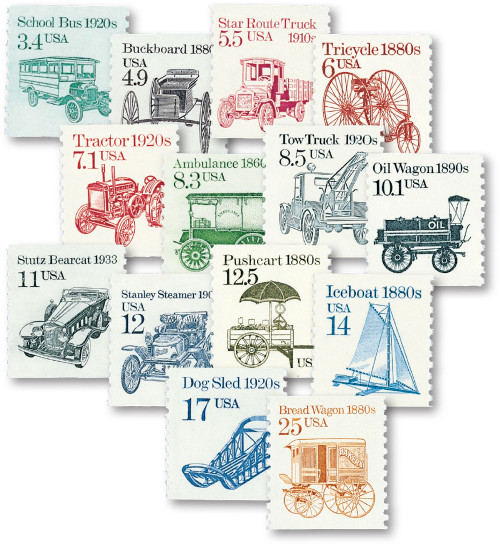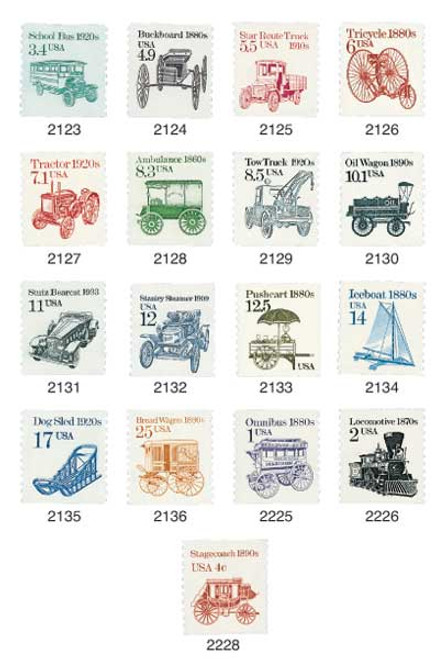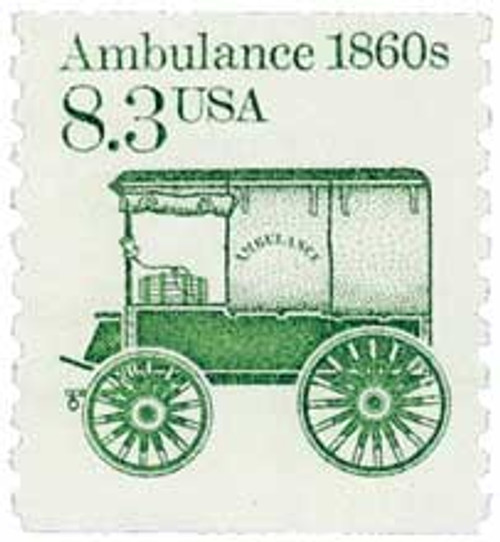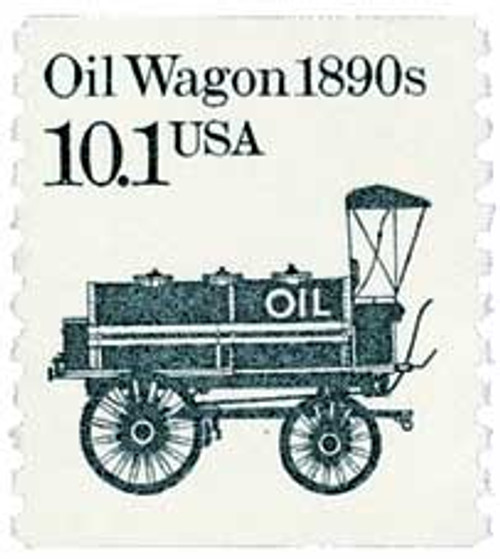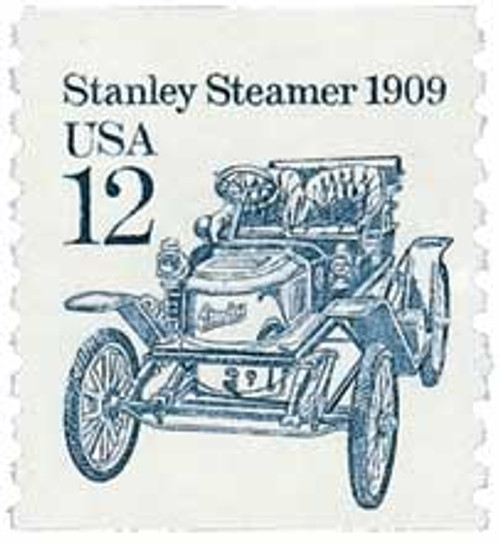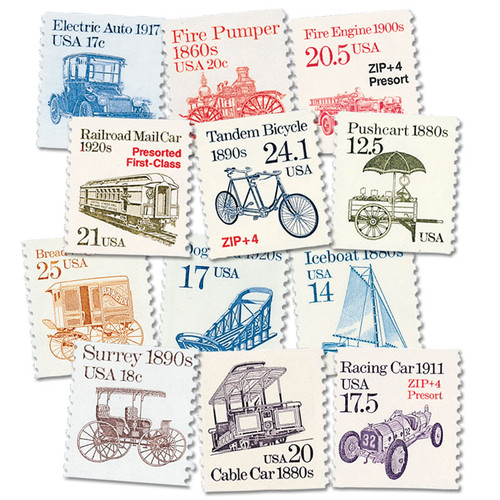
# 2126 FDC - 1985 6c Transportation Series: Tricycle 1880s
U.S. #2126
1985 6¢ Tricycle, 1880s
Transportation Series
- 19th stamp in the Transportation series
- Pictures an adult tricycle
- Paid the nonprofit third-class mail rate for mail sorted to within the first three digits of the ZIP code
Stamp Category: Definitive
Series: Transportation
Value: 6¢; nonprofit third-class three-digit ZIP code rate
First Day of Issue: May 6, 1985
First Day City: Childs, Maryland
Quantity Issued: 22,325,000
Printed by: Bureau of Engraving and Printing
Printing Method: Engraved
Format: Coils of 500 and 3,000; from printing cylinders of 936
Perforations: 10 Vertically
Color: Red brown
Why the stamp was issued: This stamp was issued for the increase from 5.2¢ to 6¢ for the on nonprofit third-class mail rate, which took effect on February 17, 1985. This stamp served a similar purpose to the 3.4¢ school bus stamp. The 6¢ stamp handled the rate for mail sorted to within the first three digits of the zip code. To use the 3.4¢ stamp, mail had to be sorted and packaged according to carrier route.
About the stamp design: Jim Schleyer, who’d designed eight Transportation stamps up to this point, suggested the Tricycle image for this stamp. While researching images for the 1984 Baby Buggy stamp, he saw an image of a tricycle in the 1887 St. Nicholas Toy Catalogue. He produced him artwork in pen and ink.
Special design details: The 6¢ Tricycle stamp was available with and without a precancel. #2126 has no precancel, while #2126a has a precancel. Precancels are stamps canceled before being sold, to make mailing faster and cheaper for customers with large amounts of mail. Bulk mailers use precancels, then pre-sort their mail and save money. The USPS makes these stamps available with and without precancels for two reasons. One reason is to create another variety for stamp collectors. The other, is so the stamps can be used as add-on postage for packages slightly overweight.
First Day City: Despite picturing an adult tricycle, this stamp was issued in Childs, Maryland, a “name-related” town. There was no official ceremony.
About the Transportation Series: On May 18, 1981, the USPS issued the first stamp in the Transportation Series, US #1907, picturing the Surrey, a doorless four-wheeled carriage. For the first time in US history, a coil stamp featured its own unique design rather than simply copying that of the current definitive stamp. Over 50 more coil stamps would be issued over the course of the next 15 years, each picturing a different mode of transportation. All of these types of transportation were used since American independence.
The various denominations provided face values to exactly match the rates for several categories of Third-Class mail (bulk rate and quantity-discounted mail). As the rates changed, new stamps with new values were added. Never before had a stamp series included so many fractional cent values.
The Bureau of Engraving and Printing printed most of the stamps in the Transportation Series, although private contractors printed a few. All but a few of the later stamps were produced by engraved intaglio. Differences in precancels, tagging, paper and gum provide a large number of varieties.
Scott Catalog separates the Transportation stamps into four groups. The stamps in the first group (#1897-1908) generally have the denomination in small type with a “c” next to it. These stamps were printed on the Cottrell rotary press, which joined together two plates to make a sleeve. The gaps between these plates created depressions where ink would collect and create joint lines on the stamps. Later issues were printed on a different press and didn’t have these joint lines.
The second group (#2123-36) had larger numbers with no “c.” The third group (#2252-66) was similar in appearance to the second group, but service inscriptions were added to the designs. These stamps also used a variety of paper and gum as well as different types of tagging. The fourth group (#2451-68) marked the end of fractional values. Now bulk mailers would use either the 5¢ or 10¢ stamp and then pay the difference from the actual postage rate.
The last stamp in the Transportation Series, the 20¢ Cog Railway, was issued on June 9, 1995, at the TEXPEX ’95 stamp show in Dallas, Texas. This marked the end of the largest US definitive series up to that time. Three new series would eventually replace it – American Transportation, American Culture, and American Scenes. Additionally, the Great Americans would go on to become the largest American definitive series.
History the stamp represents: Today the tricycle is used by children too young to ride a bicycle. When first introduced, adults rode it as well. Developed as an alternative to the French bicycle, which was high-seated, unstable, and difficult to get on and off from, the tricycle was much safer and just as fast.
U.S. #2126
1985 6¢ Tricycle, 1880s
Transportation Series
- 19th stamp in the Transportation series
- Pictures an adult tricycle
- Paid the nonprofit third-class mail rate for mail sorted to within the first three digits of the ZIP code
Stamp Category: Definitive
Series: Transportation
Value: 6¢; nonprofit third-class three-digit ZIP code rate
First Day of Issue: May 6, 1985
First Day City: Childs, Maryland
Quantity Issued: 22,325,000
Printed by: Bureau of Engraving and Printing
Printing Method: Engraved
Format: Coils of 500 and 3,000; from printing cylinders of 936
Perforations: 10 Vertically
Color: Red brown
Why the stamp was issued: This stamp was issued for the increase from 5.2¢ to 6¢ for the on nonprofit third-class mail rate, which took effect on February 17, 1985. This stamp served a similar purpose to the 3.4¢ school bus stamp. The 6¢ stamp handled the rate for mail sorted to within the first three digits of the zip code. To use the 3.4¢ stamp, mail had to be sorted and packaged according to carrier route.
About the stamp design: Jim Schleyer, who’d designed eight Transportation stamps up to this point, suggested the Tricycle image for this stamp. While researching images for the 1984 Baby Buggy stamp, he saw an image of a tricycle in the 1887 St. Nicholas Toy Catalogue. He produced him artwork in pen and ink.
Special design details: The 6¢ Tricycle stamp was available with and without a precancel. #2126 has no precancel, while #2126a has a precancel. Precancels are stamps canceled before being sold, to make mailing faster and cheaper for customers with large amounts of mail. Bulk mailers use precancels, then pre-sort their mail and save money. The USPS makes these stamps available with and without precancels for two reasons. One reason is to create another variety for stamp collectors. The other, is so the stamps can be used as add-on postage for packages slightly overweight.
First Day City: Despite picturing an adult tricycle, this stamp was issued in Childs, Maryland, a “name-related” town. There was no official ceremony.
About the Transportation Series: On May 18, 1981, the USPS issued the first stamp in the Transportation Series, US #1907, picturing the Surrey, a doorless four-wheeled carriage. For the first time in US history, a coil stamp featured its own unique design rather than simply copying that of the current definitive stamp. Over 50 more coil stamps would be issued over the course of the next 15 years, each picturing a different mode of transportation. All of these types of transportation were used since American independence.
The various denominations provided face values to exactly match the rates for several categories of Third-Class mail (bulk rate and quantity-discounted mail). As the rates changed, new stamps with new values were added. Never before had a stamp series included so many fractional cent values.
The Bureau of Engraving and Printing printed most of the stamps in the Transportation Series, although private contractors printed a few. All but a few of the later stamps were produced by engraved intaglio. Differences in precancels, tagging, paper and gum provide a large number of varieties.
Scott Catalog separates the Transportation stamps into four groups. The stamps in the first group (#1897-1908) generally have the denomination in small type with a “c” next to it. These stamps were printed on the Cottrell rotary press, which joined together two plates to make a sleeve. The gaps between these plates created depressions where ink would collect and create joint lines on the stamps. Later issues were printed on a different press and didn’t have these joint lines.
The second group (#2123-36) had larger numbers with no “c.” The third group (#2252-66) was similar in appearance to the second group, but service inscriptions were added to the designs. These stamps also used a variety of paper and gum as well as different types of tagging. The fourth group (#2451-68) marked the end of fractional values. Now bulk mailers would use either the 5¢ or 10¢ stamp and then pay the difference from the actual postage rate.
The last stamp in the Transportation Series, the 20¢ Cog Railway, was issued on June 9, 1995, at the TEXPEX ’95 stamp show in Dallas, Texas. This marked the end of the largest US definitive series up to that time. Three new series would eventually replace it – American Transportation, American Culture, and American Scenes. Additionally, the Great Americans would go on to become the largest American definitive series.
History the stamp represents: Today the tricycle is used by children too young to ride a bicycle. When first introduced, adults rode it as well. Developed as an alternative to the French bicycle, which was high-seated, unstable, and difficult to get on and off from, the tricycle was much safer and just as fast.







